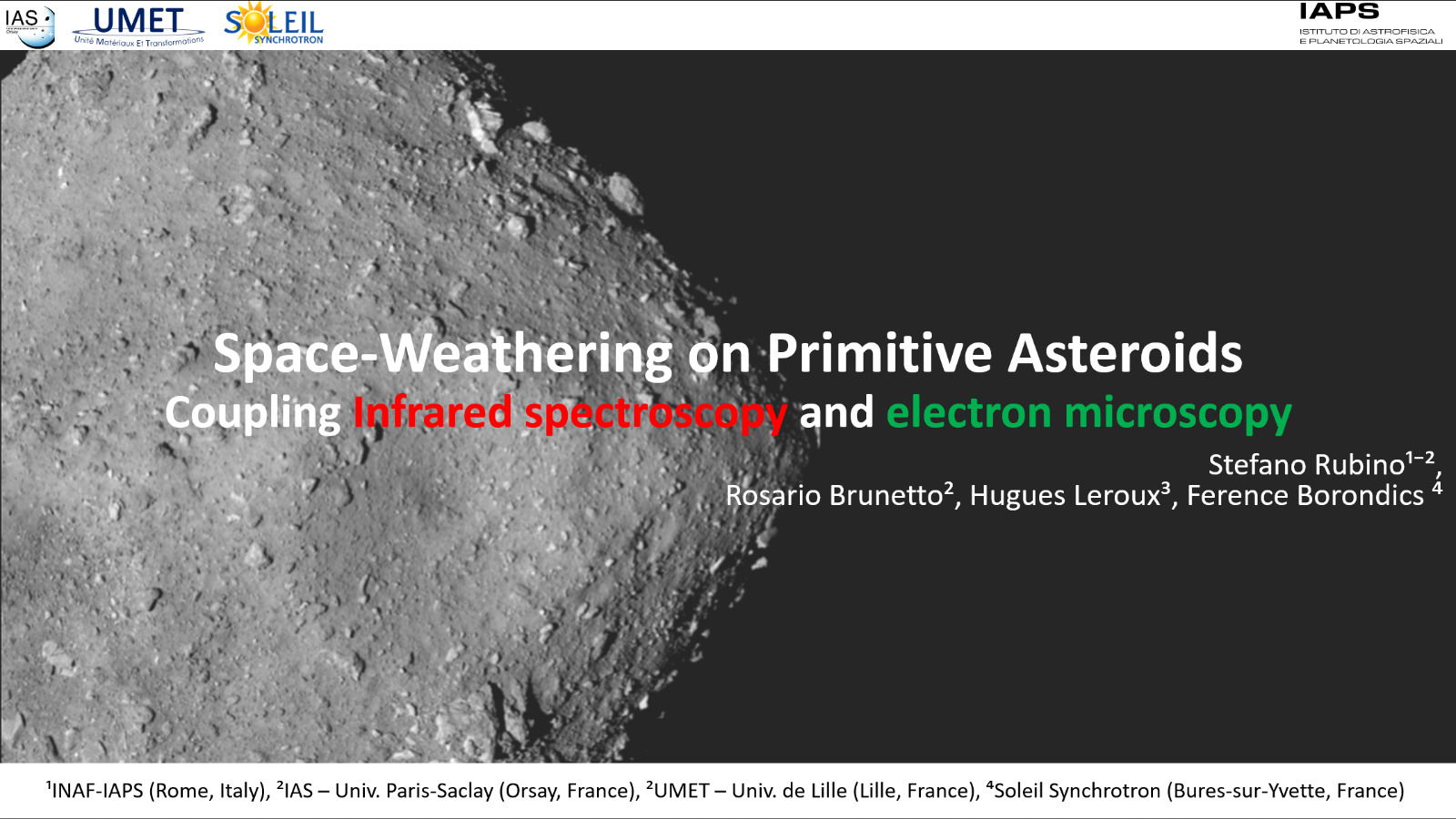
- Questo evento è passato.
Space-Weathering on Primitive Asteroids
Dicembre 6, 2023 @ 11:30 am - 12:30 pm

Recording: https://www.oact.inaf.it/seminars/
DATE: Wednesday, December 6, 11:30 a.m.
ORGANIZER: INAF OACT
LOCATION: AULA OVEST (INAF-OACT) + remote
Link for the remote audience:
https://meet.google.com/wvf-uwxo-oyj
SPEAKER: Dr. Stefano Rubino (INAF-IAPS)
ABSTRACT:
Studying small bodies in our solar system is fundamental for understanding its youth and evolution. These small “primitive” bodies are “undifferentiated” (they did not undergo phase density separation, irreversibly altering their mineralogy). They have evolved little since their creation, spurring a composition relatively close to the primordial proto-planetary disk. However, other processes, such as thermal alteration, aqueous alteration, shocks, or space-weathering, can affect these bodies’ surfaces. This issue is because remote-sensed data acquired while studying these bodies target these surfaces. If these surfaces have been altered, they can induce a particular bias in the study of the composition of these small bodies. Therefore, it is paramount to understand the processes affecting the surface of primitive asteroids to assess their composition correctly.
There are several ways to study the surface of primitive asteroids, such as remotely, from the Earth or a satellite orbiting the body of interest, by acquiring spectroscopic data (gaining access to surface chemical and mineralogical composition). It is also possible to study these bodies in a laboratory environment by working on analogous materials, such as certain classes of “primitive” meteorites (carbonaceous chondrites), on terrestrial analogs (simpler to study than meteorites but less closely related to extraterrestrial materials), or directly on extraterrestrial materials brought back by sample return missions.
In this work, we replicate the effects of space weathering (SpWe) on the surface of primitive asteroids in a laboratory environment. More specifically, we focus on the effects of solar wind, the dominant SpWe process on “young” surfaces of the solar system. We have chosen three terrestrial minerals analogous to a “primitive” surface – three hydrated minerals (two serpentines and one saponite) – of which we have produced several pellets which have been bombarded using He and Ar ions, to investigate the effects of two different solar wind. In doing so, we made analogous materials of weathered primitive surface matter.
These analogs were then characterized by infrared spectroscopy, from the visible to the far-infrared range, to study chemical changes prompted by ion bombardment. This was done by investigating how certain spectroscopic features – characteristic of hydrated silicates – changed upon ion bombardment. We detected several effects, such as darkening in the visible range, visible slope reddening and bluing, and a systematic shift towards longer wavelength affecting the position of several spectroscopic features.
This spectroscopic characterization was followed by a study at a smaller scale using electron microscopy. We first characterized the surface of our weathered analogs using scanning electron microscopy. Then, we investigated the morphological and physicochemical changes in the bombarded layer, at a nanometer scale using transmission electron microscopy. Strong vesiculation effects of various kinds were identified in the ion-bombarded amorphized layers, textural changes, and some elemental concentration evolution (such as the loss of oxygen in the utmost top surfaces, preferential amorphization of magnesium, etc.). The coupling between these two techniques, IR spectroscopy, and electron microscopy acting at different scales, has allowed for a better understanding of SpWe effects on primitive bodies and will be able to support current and future studies of primitive bodies, whether they are carried out remotely or in a laboratory environment on returned samples.
A few rules:
— in case of large in-person attendance, attendees may be asked to wear a face mask
— before joining, make sure you are using your institutional inaf.it account if you have one (otherwise we will grant you permission to join)
— please do not forget to mute your microphone and switch off your webcam when access the virtual room
— for questions leave a message in the chat, the answers at the end of the webinar
— the seminar will be recorded, so if you are interested in it, please contact us to get the link to the registration.